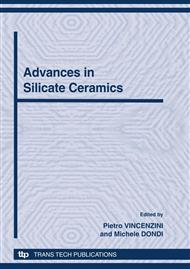p.13
p.23
p.31
p.38
p.44
p.53
p.59
p.65
p.75
Synthesis of Hybrid Lamellar Silica by Liquid Crystal Templating and Silanation
Abstract:
This paper is focused on the preparation and characterization of different lamellar silica prepared by liquid crystal templating and silanisation. The initial template can be removed and replaced in the interlamellar spaces by different types of silane, being covalently grafted to the solid by reaction with the surface silanols. The lamellar stacking periodicity remains after this modification. The surfactant extraction can lead in significant grafting of isopropanol if the solid is simply refluxed in isopropanol, which have the effect of preserving the periodicity of the lamellar stacking. The surfactant extraction in an Soxhlet equipment avoid this reaction, with the effect of platelets organization collapsing. The lamellar silica studied exhibit great specific surface and combination of meso and microporosity, making them interesting materials for nanocomposite or catalysis applications.
Info:
Periodical:
Pages:
44-52
Citation:
Online since:
October 2010
Keywords:
Price:
Сopyright:
© 2010 Trans Tech Publications Ltd. All Rights Reserved
Share:
Citation:


